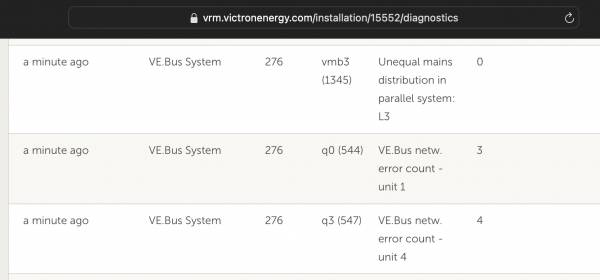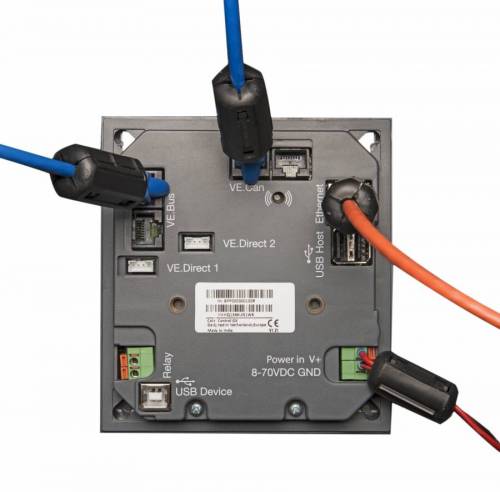Table of Contents
Troubleshooting VE.Bus network interference
This guide is intended to rule out VE.Bus cables as a cause when troubleshooting spurious VE.Bus error codes. This guide should be considered when the VE.Bus errors appear to be triggered and exacerbated by some load types, load sizes, connection or disconnection of the AC input, temperature, physical disturbance, age, corrosion, and more.
This guide should be followed as a pre-cursour to escalation and potential RMA of the GX device and/or the Inverter/chargers. Ideally the advice here should be implemented pre-emptively by Victron Installers on new installations to prevent these issues occurring in the first place, and to speed up troubleshooting or replacement if VE.Bus errors arise.
Physical and EM Interference
Use Manufactured Cables! Always use manufactured cables rather than crimping them onsite. A lot happens at the point of contact. Attempting to crimp cables on site will increase the odds of these issues. The amount of noise to signal goes up dramatically on a less than perfect crimp that visually looks fine and tests ok for continuity.
Separation and Cable Management: The intensity of interference from power cables follows an inverse square law. Maintaining separation is important, and bundling power and comms cables together should always be avoided.
If you have VE.Bus errors, and they aren't corrected by simply replacing the communications cables, then they likely need to also be re-routed. Even temporary (though still secure) re-routings can help to rule out this as a cause of issues before escalating to the replacement of hardware (such as the GX device or Inverters).
Interference Intensity at Various Distances
- At 1 cm (data cables side by side with power cables), the relative interference intensity is 100%.
- At 2 cm, the intensity reduces to 25%.
- At 3 cm, it further drops to approximately 11.11%.
- At 10 cm, the interference is only 1% of what it is at 1 cm.
- At 20 cm, the interference falls to 0.25% (from then on can usually be assumed safe)
- At 100 cm, the intensity is a mere 0.01% (99.9% reduction, but usually impractical)
Length of Run: The longer the run of the cables, especially when in parallel with power cables, the worse the effect, necessitating greater separation. Also the longer the communications cables run generally the weaker the signal and the greater the noise. So minimise the lengths where possible and avoid bundling or coiling excess. Use a shorter manufactured cable if possible.
Type of Current: DC solar cables are the most likely to cause interference. AC cables are more likely to cause interference than DC battery cables. Other data communications cables will rarely cause interference.
VE.Bus Network Error Count
The network quality counters in the VE.Bus system track the number of frame retransmissions required after a VE.Bus device receives an invalid frame. These counters can be accessed via VRM by adding /diagnostics to the VRM URL for a site. They are reset after you ‘reset' the VE.Bus system on the GX device in the Multi Advanced menu.
Key Points on the Counter
The counters operate on the protocol level, not the application level. This means that if a VE.Bus cable connection between two units in a parallel system is removed, the counters in both units will not increment, as the frames are still being sent correctly to all connected devices at the protocol level.
But on the application level, if a Multi in a parallel system is missing, the system will switch off automatically, and a VE.Bus error will be written. However, this event might not reflect in the network quality counters which require a checksum failure (the message is received but it’s wrong or corrupt). So the connection has to be good enough that at least some of it is received.
Impact of these errors
Small Systems: In smaller setups with a single unit, delays and retransmissions from a Multi to a GX device may not even have noticeable effects.
Large Systems: In larger configurations with numerous VE.Bus devices, the impact of errors grows exponentially, potentially leading to “Error 3 - Not all, or more than, the expected devices were found in the system.” And alike. Current is also higher, so more interference is created, so more attention is required.
Normal Counter Levels
They accrue over time, so it’s hard to pin down. It’s an indicator. A high network error count is often correlated with other issues, but not always, and a high count is not a fault unto itself unless it presents with other issues. Post-commissioning and VE.bus system reset, a count should be 0.
Rather than there being some objective number that Is acceptable or not, treat it as a diagnostic on a per system basis. Check the counter, if it’s a new system and it’s more than 10, there is a problem. Make the changes you can to reduce interference, reset the counter, and then use it to help see if you were successful without waiting for a system shutdown.
Note if there is variation in the counter levels between units then focus your attention on those with higher numbers, it might indicate where the interference or issue is coming from within the physical installation.
Ferrite core cable clips
The use of Ferrite core noise suppressing cable clips can also help filter out noise. These are a widely available part and available very cheaply. Some Ferrite core clips are supplied with GX devices and should be attached to the GX cables to reduce in-line noise and interference. The GX power supply ferrite can be installed with a loop to keep it secure.
While not normally necessary, if VE.Bus network errors persist install ferrites on each communications cable in the system at each point of connection. This includes the comms cables between each inverter, between the master inverter and the GX, and the battery comms cables.
VE.Bus network topology
The VE.Bus network is a bus topology, not a ring or any other configuration.
This means the optimal arrangement is a single RJ45 cable link from the GX device, to the first VE.Bus inverter/charger and then daisy chain to subsequent VE.Bus inverter/chargers if they exist.
There is no termination required at either end, nor should any be used. The end-ports of the VE.Bus should be left open, or blanked out with no connection made. Do not loop the cable around to those end points.
 Add this page to your book
Add this page to your book  Remove this page from your book
Remove this page from your book  Manage book (
Manage book ( Help
Help 
